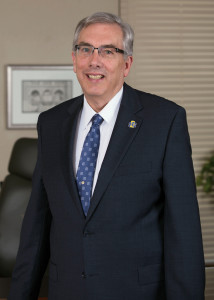On Jan. 12, we hosted a campus event to kick off the planning stage for SDSU’s next strategic plan. By design, that process—being led by Interim Provost Dennis Hedge and  Vice President for Student Affairs Michaela Willis—will be an extensive and collaborative one, actively engaging the campus community and external stakeholders to develop a plan rooted in our values as South Dakota’s 1862 land-grant university.
Vice President for Student Affairs Michaela Willis—will be an extensive and collaborative one, actively engaging the campus community and external stakeholders to develop a plan rooted in our values as South Dakota’s 1862 land-grant university.
We often hear about the three aspects of the university’s land-grant mission: teaching, research and outreach. Together, those differentiate us from other universities.
There’s no question that an academic experience at a university with a research mission is unique, one that distinguishes us from our peers and competitors and that brings value, not just to the educational experiences we offer, but in tangible ways to the larger community we serve.
Research links directly with academic excellence and our teaching mission. It means our faculty are fresher and in many ways more engaged. They are immersed in their disciplines at a deeper level and they are into the literature. They publish, they participate in professional organizations and they present their research. They foster the next generation of scholars and researchers. And they understand that the purpose of their work and the knowledge they generate goes beyond the prestige it might bring to themselves and the institution, because it truly is part of an effort to address some of the grand challenges facing our world today.
The research mission also is linked to our outreach mission. That’s not the case at other kinds of institutions—not at private colleges, not at smaller public universities that might have a bit of scholarship and research, and not even at most of the larger publics that have fairly significant research portfolios. Their outreach simply does not compare to what goes on here.
And that outreach is more than just SDSU Extension. Certainly, Extension is a focal point and it’s easy to talk about. But along with the 750,000 people using Extension’s online portal, iGrow, we have some 10,000 young people who come to campus from our communities to participate in camps. We have programs targeted to address the specific needs of people and communities around the state. And we have collaborative efforts—both direct and indirect—with other organizations and institutions that help improve quality of life for all of our stakeholders.
Let me give you a couple of examples.
For the past two years, the founding director of our English as a second language program, Nathan Ziegler, has been working with our Office of Continuing and Distance Education to develop an online ESL program to provide a service to the growing immigrant and refugee populations in the state who, frankly can’t afford the campus program. An online program, however, can be made available for a fraction of the cost and offer working people the opportunity to study English on their own time. Nathan and company currently are working with the Greater Huron Development Corporation seeking ways to fund and implement an affordable and effective pilot program for nonnative English speakers employed by the Dakota Provisions Turkey Plant and other businesses in that area.
Nobody suggested to Nathan that he should do that: That’s the culture of a land-grant university.
Recently, I had a conversation with Rob Oliver, the president of Augustana. He told me how SDSU helped Augustana’s nursing program achieve accreditation by providing them with a source of academically prepared faculty members who had earned either a master’s or Ph.D. in nursing at SDSU. Our program also provides highly qualified educators to other schools around the state and beyond. That’s outreach that directly impacts our communities by improving the quality of health care all across our region.
I don’t know that I can paint the picture rich enough or weave the fabric as beautifully as it really is about this part of the land-grant mission. It just permeates the university and its people.
The research impacts our teaching. The research impacts our outreach. And underpinning those, the one thing that really differentiates us is access.
Right now, national discussions about the future of higher education are talking about the same kinds of concerns they had back in the mid-19th century when they were looking for new ways to extend the benefits of higher education to people and populations, immigrants and others who traditionally had been shut out of academia. They understood then that doing so not only would improve quality of life for those individuals who gained that opportunity, but also for the communities they would return to and for the larger society to which they belonged.
Those aspirations really were the seeds of the emergence of the land-grant system, and they are just as relevant and just as important today.
It all emanates from access.
You want people to have jobs and you need them in the economy. You also want them to be educated and engaged, voting and volunteering to make their communities better places. That’s why extending access will be a key part of our strategic planning process and a foundational underpinning of those three essential aspects of our land-grant mission as we go forward.
We may have to stretch ourselves—we live in times where limited resources is the new norm—but I believe our hearts remain open enough and our belief in that land-grant mission remains strong enough that we will succeed.






